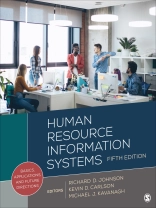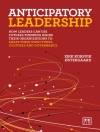Human Resource Information Systems: Basics, Applications, and Future Directions is a one-of-a-kind book that provides a thorough introduction to the field of Human Resource Information Systems (HRIS) and shows how organizations today can leverage HRIS to make better people decisions and manage talent more effectively. Unlike other texts that overwhelm students with technical information and jargon, this revised Fifth Edition offers a balanced approach in dealing with HR issues and IT/IS issues by drawing from experts in both areas. It includes the latest research and developments in the areas of HRIS justification strategies, HR technology, big data, and artificial intelligence. Numerous examples, best practices, discussion questions, and case studies, make this book the most student-friendly and current text on the market.
Included with this title:The password-protected Instructor Resource Site (formally known as SAGE Edge) offers access to all text-specific resources, including a test bank and editable, chapter-specific Power Point® slides.
Mục lục
Preface
Acknowledgments
Part I: Human Resource Information Systems (HRIS)
Chapter 1: The Evolution of HRM and HRIS – Richard D. Johnson and Kevin D. Carlson
Editors’ Note
Chapter Objectives
HRIS in Action
Introduction
HR Activities
Technology and Human Resources
Evolution of HRM and HRIS
HRIS Within the Broader Organization and Environment
Themes of the Book
Summary
Key Terms
Discussion Questions
Case Study: Position Description and Specification for an HRIS Administrator
Chapter 2: Systems Considerations in the Design of an HRIS – Michael D. Bedell and Michael L. Canniff
Editors’ Note
Chapter Objectives
Industry Brief: Jim Pascarell, President, Integra Optics
HRIS in Action
Introduction
HRIS Customers/Users: Data Importance
HRIS Architecture
Best of Breed
Planning for System Implementation
Summary
Key Terms
Discussion Questions
Case Study: HRIS in Action Revisited
Part II: Managing HRIS Implementations
Chapter 3: The Systems Development Life Cycle and HRIS Needs Analysis – Lisa M. Plantamura and Richard D. Johnson
Editors’ Note
Chapter Objectives
Industry Brief: Dan Staley, Partner, Pw C
HRIS in Action: Failing to Plan Is Planning to Fail
Introduction
The Systems Development Life Cycle
Analysis
Needs Analysis
Summary
Key Terms
Discussion Questions
Case Study: Planning the Needs of Other Organizations
Chapter 4: System Design and Acquisition – Richard D. Johnson and James H. Dulebohn
Editors’ Note
Chapter Objectives
Industry Brief: Jeffrey D. Miller, Deloitte Consulting
HRIS in Action
Introduction
Design Considerations During the Systems Development Life Cycle
Working With Vendors
Assessing System Feasibility
Summary
Key Terms
Discussion Questions
Case Study: Larson Property Management Company
Chapter 5: Change Management and System Implementation – Richard D. Johnson and Michael J. Kavanagh
Editors’ Note
Chapter Objectives
HRIS in Action
Introduction to the Management of Change
Models of the Change Process
Selected Change Models
Why Do System Failures Occur?
HRIS Implementation
Critical Success Factors in HRIS Implementation
Summary
Key Terms
Discussion Questions
Case Study: The Grant Corporation
Chapter 6: Cost-Justifying HRIS Investments – Kevin D. Carlson and Michael J. Kavanagh
Editors’ Note
Chapter Objectives
Industry Brief: Hillary Brotman, Director, Huron Consulting Group
HRIS in Action
Introduction
HRIS Benefit-Cost Analysis
Implementation Costs
Estimating the Value of Indirect Benefits
Estimating Indirect Benefit Magnitude
Mapping Indirect Benefits to Revenues and Costs
Methods for Estimating the Value of Indirect Benefits
Estimating the Timing of Benefits and Costs
Avoiding Common Problems
Packaging the Analysis for Decision Makers
Conclusion
Summary
Key Terms
Discussion Questions
Case Study: Justifying an HRIS Investment at Investment Associates
Part III: Human Resource Information Systems Applications
Chapter 7: HR Administration and HRIS – Linda C. Isenhour and Christopher J. Hartwell
Editors’ Note
Chapter Objectives
HRIS in Action
Introduction
The HRIS Environment and Other Aspects of HR Administration
HRM Administration and Organizing Approaches
Legal Compliance and HR Administration
HR Administration and Equal Employment Opportunity
HR Strategic Goal Achievement and the Balanced Scorecard
Summary
Key Terms
Discussion Questions
Case Study: The Calleeta Corporation
Chapter 8: Talent Management and HR Planning – Richard D. Johnson and Michael J. Kavanagh
Editors’ Note
Chapter Objectives
Industry Brief: Michelle Tenzyk, Chief Executive Officer, East Tenth Group
HRIS in Action
Introduction
Talent Management
Technology and Talent Management
Human Resource Planning
Summary
Key Terms
Discussion Questions
Case Study: HRIS in Action Case Continued
Chapter 9: Recruitment and Selection in an Internet Context – Kimberly M. Lukaszewski and David N. Dickter
Editors’ Note
Chapter Objectives
HRIS in Action
Introduction
Recruitment and Technology
Online Recruitment Guidelines
Selection and Technology
Summary
Key Terms
Discussion Questions
Case Study: Recruitment and Selection in a Global Organization
Chapter 10: Training and Development – Ralf Burbach and Steven D. Charlier
Editors’ Note
Chapter Objectives
Industry Brief: Richard Gegenwarth, Strategic Change Management Leader, Guardian Life
HRIS in Action
Introduction
Training and Development: Strategic Implications and Learning Organizations
Training Metrics and Benefit-Cost Analysis
HRIS Applications in Training
Summary
Key Terms
Discussion Questions
Case Study: Training and Development at Meddevco
Chapter 11: Rewarding Employees and HRIS – Charles H. Fay and Hadi El-Farr
Editors’ Note
Chapter Objectives
Industry Brief: Matthew Cotugno, Leader, Total Rewards, MVP Health Care
HRIS in Action
Introduction
Performance Management
Compensation
Benefits
Payroll
Summary
Key Terms
Discussion Questions
Case Study: Grandview Global Financial Services, Inc.
Chapter 12: Strategic Considerations in HRIS – Huub Ruël and Tanya Bondarouk
Editors’ Note
Chapter Objectives
HRIS in Action
Introduction
HRM and Technology
e HRM: From Strategy to Results
e HRM and the HRM Function
The Future of e HRM
Summary
Key Terms
Discussion Questions
Part IV: Advanced HRIS Applications and Future Trends
Chapter 13: HRIS and International HRM – Michael J. Kavanagh and Miguel R. Olivas-Luján
Editors’ Note
Chapter Objectives
Industry Brief: Roy J. Wood, Jr., Executive Vice President of Professional Services, Insurity
HRIS in Action
Introduction
HR Programs in Global Organizations
HRIS Applications in IHRM
Summary
Key Terms
Discussion Questions
Case Study: Global Issues in a Multinational Company
Chapter 14: HR Metrics and Workforce Analytics – Kevin D. Carlson and Michael J. Kavanagh
Editors’ Note
Chapter Objectives
HRIS in Action
Introduction
A Brief History of HR Metrics and Analytics
Limitations of Historical Metrics
Contemporary HR Metrics and Workforce Analytics
HR Metrics, Workforce Analytics, and Organizational Effectiveness
So Where Are the Best Workforce Analytics Opportunities Likely to Be Found?
An Example Analysis: The Case of Staffing
Building a Workforce Analytics Function
Useful Things to Remember About HR Metrics and Analytics
Summary
Key Terms
Discussion Questions
Case Study: Regional Hospital
Chapter 15: HRIS Privacy and Security – Humayun Zafar and Dianna L. Stone
Editors’ Note
Chapter Objectives
HRIS in Action
Introduction
Employee Privacy in a Global Environment
Components of Information Security
Information Policy and Management
Summary
Key Terms
Discussion Questions
Case Study: Practical Applications of an Information Privacy Plan
Chapter 16: The Role of Social Media in HR – Stephanie L. Black and Andrew F. Johnson
Editors’ Note
Chapter Objectives
HRIS in Action
Introduction
Global Social Media Platform Use
Social Media and HR Practices
Concerns Over Social Media
Guidelines for Corporate Social Media Policies
Research-Based Tips for the Use of Social Media in HR
Summary
Key Terms
Discussion Questions
Chapter 17: The Future of HRIS – Richard D. Johnson and Kevin D. Carlson
Editors’ Note
Chapter Objectives
Introduction
Future Trends in HRM
Future Trends in HRIS
Summary
Discussion Questions
Key Terms
Glossary
References
About the Editors
About the Contributors
Notes
Index
Giới thiệu về tác giả
Michael J. Kavanagh is Professor Emeritus of Management at the State University of New York at Albany. He is past editor of Group & Organization Management and a fellow of the American Psychological Association, the American Psychological Society, the Society for Industrial and Organizational Psychology, and the Eastern Academy of Management. He has been involved in the HRIS field since 1982. He established the HRIS MBA program at the University at Albany in 1984 and has taught numerous courses in the field of HRIS. In 2006, he received the Award for Career Excellence from the International Association for Human Resource Information Management (IHRIM). He received his Ph D in industrial/organizational psychology from Iowa State University in 1969.












